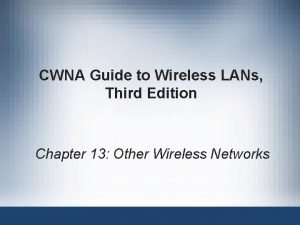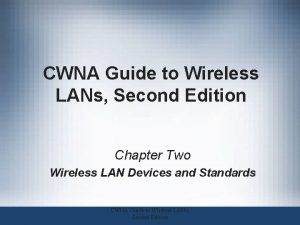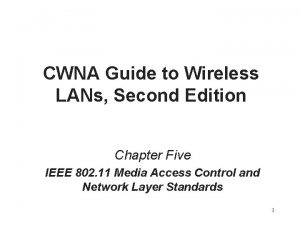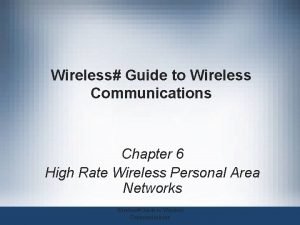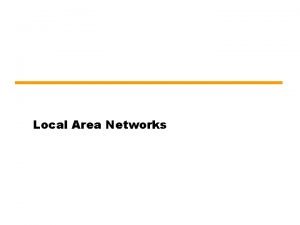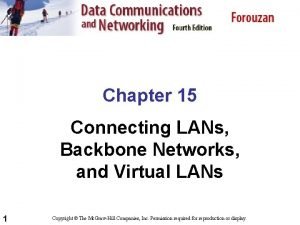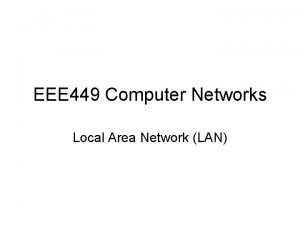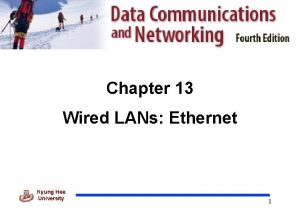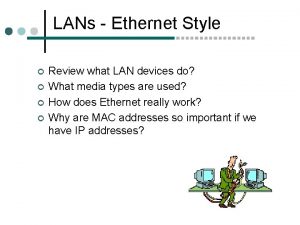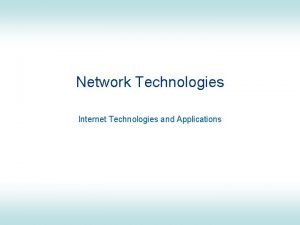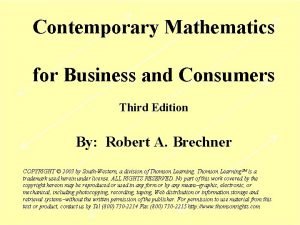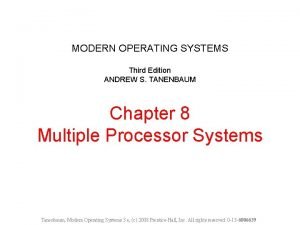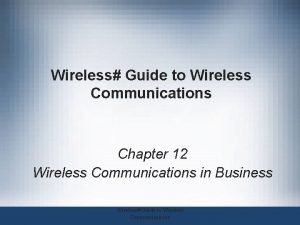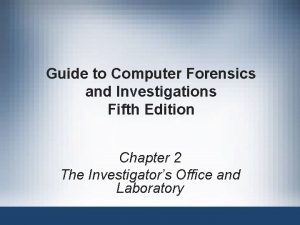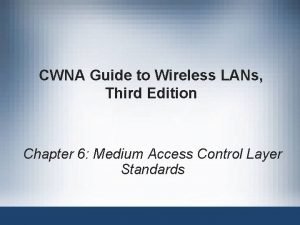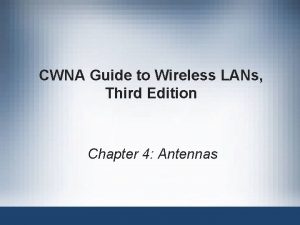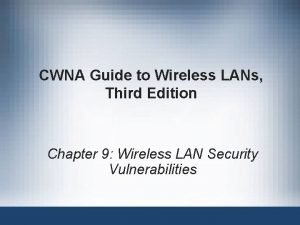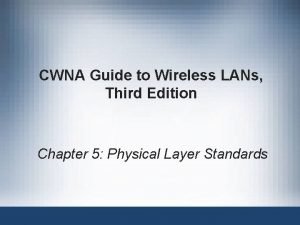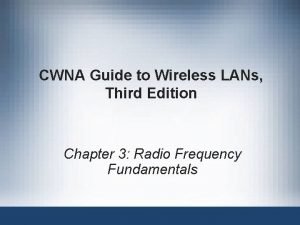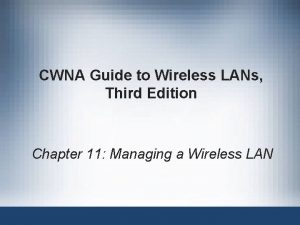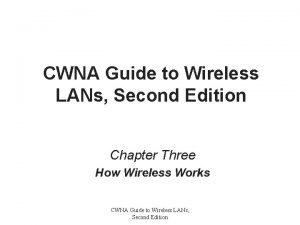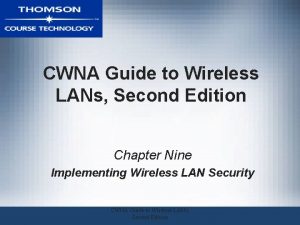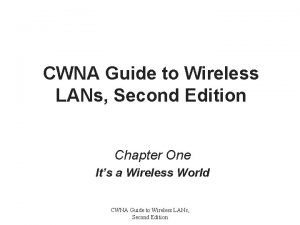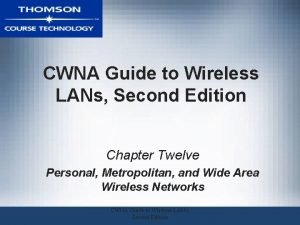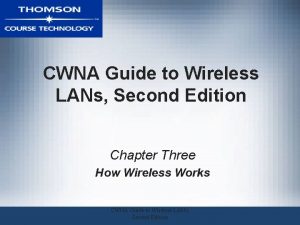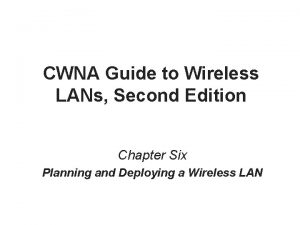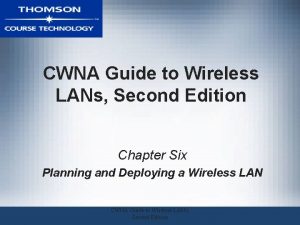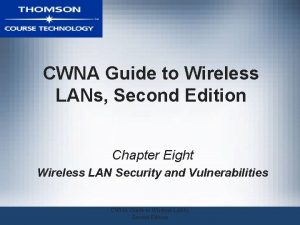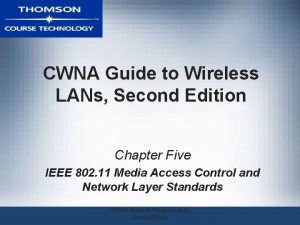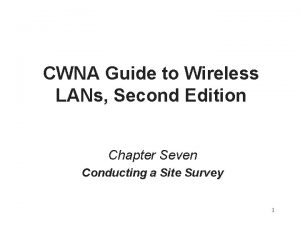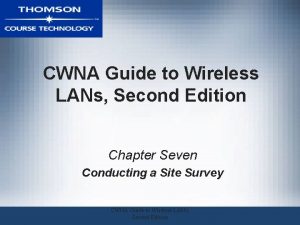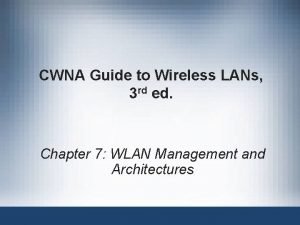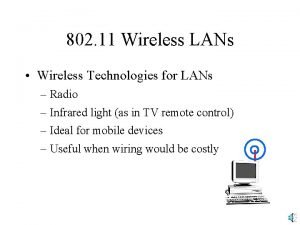CWNA Guide to Wireless LANs Third Edition Chapter












































- Slides: 44

CWNA Guide to Wireless LANs, Third Edition Chapter 13: Other Wireless Networks

Objectives • Define the technologies found in a wireless personal area network • Explain the uses of a wireless metropolitan area network • List the technologies of a wireless wide area network • Describe the IEEE 802. 11 ac proposed standard CWNA Guide to Wireless LANs, Third Edition © 2013 Cengage Learning 2

Wireless Personal Area Networks (IEEE 802. 15) • WPAN technologies: – – – Bluetooth (802. 15. 1 -2005) Ultrawideband (802. 15. 3 c-2009) Low rate technologies (802. 15. 4) Body Area Networks (802. 15. 6) Visible Light Communications (802. 15. 7) CWNA Guide to Wireless LANs, Third Edition © 2013 Cengage Learning 3

Bluetooth (802. 15. 1 -2005) • Bluetooth uses short-range RF transmissions – Users can connect wirelessly to wide range of computing and telecommunications devices – Rapid and ad hoc connections between devices • Current version is Bluetooth v 4. 0 – Rate of transmission is 1 million bits per second • Two types of 802. 15. 1 network topologies – Bluetooth Piconet – Bluetooth Scatternet CWNA Guide to Wireless LANs, Third Edition © 2013 Cengage Learning 4

Bluetooth (802. 15. 1 -2005) • Bluetooth piconet: When two 802. 15. 1 devices come within range, automatically connect – Master: Controls wireless traffic – Slave: Takes commands from master – Piconet has one master and at least one slave • Active slave: Connected to piconet and sending transmissions • Parked slave: Connected but not actively participating CWNA Guide to Wireless LANs, Third Edition © 2013 Cengage Learning 5

Figure 13 -2 Bluetooth piconet CWNA Guide to Wireless LANs, Third Edition © 2013 Cengage Learning 6

Figure 13 -3: Slave device detected by master CWNA Guide to Wireless LANs, Third Edition © 2013 Cengage Learning 7

Bluetooth (802. 15. 1 -2005) • Devices in piconet can be in one of five modes: – Standby: Waiting to join a piconet – Inquire: Device looking for devices to connect to – Page: Master device asking to connect to specific slave – Connected: Active slave or master – Park/Hold: Part of piconet but in low-power state • Bluetooth scatternet: Group of piconets in which connections exist between different piconets • 802. 15. 1 uses FHSS CWNA Guide to Wireless LANs, Third Edition © 2013 Cengage Learning 8

Figure 13 -4 Bluetooth scatternet CWNA Guide to Wireless LANs, Third Edition © 2013 Cengage Learning 9

Bluetooth (802. 15. 1 -2005) • A major drawback of Bluetooth is its slow speed • Attacks on wireless Bluetooth technology is not uncommon • Two Bluetooth attacks: – Bluejacking: an attack that sends unsolicited messages to Bluetooth-enabled devices – Bluesnarfing: an attack that accesses unauthorized information from a wireless device through a Bluetooth connection CWNA Guide to Wireless LANs, Third Edition © 2013 Cengage Learning 10

Ultra-Wideband (802. 15. 3 c-2009) • Ultra-wideband (UWB): high-rate WPAN with speeds over 2 Gbps • Created in response to limitations of 802. 15. 1 • Two main applications: – Video and audio distribution for home entertainment systems • High-speed digital video transfer • Interactive video gaming – Higher-speed data transfer intended for MP 3 players, personal home storage devices, printers, scanners, and transfers to and from digital still cameras and kiosks CWNA Guide to Wireless LANs, Third Edition © 2013 Cengage Learning 11

Ultra-Wideband (802. 15. 3 c-2009) • UWB has not been widely implemented • It distributes a signal across a wide range of spectrum – Widespread interference on other transmissions is a concern – FAA an other Federal agencies claimed that UWB could interfere with critical safety equipment, such as aircraft radar and communications CWNA Guide to Wireless LANs, Third Edition © 2013 Cengage Learning 12

Table 13 -2 UWB features CWNA Guide to Wireless LANs, Third Edition © 2013 Cengage Learning 13

Low Rate Technologies (802. 15. 4) • Sometimes preferable to have low-speed, lowpower wireless devices – Size can be dramatically reduced • IEEE 802. 15. 4 standard addresses requirements for RF transmissions requiring low power consumption and cost Table 13 -3 IEEE 802. 15. 4 data rates and frequencies CWNA Guide to Wireless LANs, Third Edition © 2013 Cengage Learning 14

Low Rate Technologies (802. 15. 4) • Zig. Bee: low-power, short-range, and low-data rate specification that is based on 803. 15. 4 but that includes standards for network configuration, security, and other high-level features • Typically found in the following applications: – – Smart lighting Advanced temperature control Medical data collection Smoke and intruder detection CWNA Guide to Wireless LANs, Third Edition © 2013 Cengage Learning 15

Low Rate Technologies (802. 15. 4) • Radio Frequency Identification (RFID): RFID tags are able to receive and respond to queries from an RFID transceiver • Passive RFID tags: No power supply – Can be very small – Limited amount of information transmitted • Active RFID tags: Must have power source – Longer ranges/larger memories than passive tags CWNA Guide to Wireless LANs, Third Edition © 2013 Cengage Learning 16

Low Rate Technologies (802. 15. 4) • Common applications for RFID tags: – Automobile toll booths for electronic toll collection – Asset tracking – Embedded in tires to ensure tire-tracking capabilities – Cards with embedded RFID chips are used in casinos and to pay mass transit fares – Smart Keys – U. S. passports CWNA Guide to Wireless LANs, Third Edition © 2013 Cengage Learning 17

Body Area Networks (802. 15. 6) • IEEE 802. 15. 6 group is currently creating a standard for body area networks (BAN) • BAN is a network system of devices in close proximity to a person’s body that cooperate for the benefit of the user • Commonly used for sports and fitness monitoring • Sensors can be placed on the body to monitor EKG impulses, blood pressure, glucose, and others – Transmitted via computer or smartphone to a physician who can make care decisions • Known as a managed body sensor network (MBSN) CWNA Guide to Wireless LANs, Third Edition © 2013 Cengage Learning 18

Body Area Networks (802. 15. 6) • Autonomous body sensor network (ABSN): network that introduces actuators in addition to sensors so that immediate effects can be made on the human body – Devices take in signals from the human nervous system and then stimulate nerves through electrical charges • Causes muscles to contract and limbs to move • Bypasses areas of the nervous system that have been impaired by strokes, spinal cord or brain injuries CWNA Guide to Wireless LANs, Third Edition © 2013 Cengage Learning 19

Figure 13 -5 Managed body sensor network CWNA Guide to Wireless LANs, Third Edition © 2013 Cengage Learning 20

Visible Light Communications (802. 15. 7) • Light can be used instead of RF • One of the first WPAN technologies using light is based on a standard known as Ir. DA (Infrared Data Association) • Ir. DA devices can transmit from 9. 6 Kbps - 16 Mbps • Devices communicate using infrared light-emitting diodes – Recessed into device – Many design considerations affect Ir. DA performance CWNA Guide to Wireless LANs, Third Edition © 2013 Cengage Learning 21

Figure 13 -6 Ir. DA diodes in device CWNA Guide to Wireless LANs, Third Edition © 2013 Cengage Learning 22

Visible Light Communications (802. 15. 7) • Ir. DA drawbacks: – Designed to work like standard serial port on a personal computer, which is seldom used today – Cannot send and receive simultaneously – Strong ambient light can negatively impact transmissions – Angle and distance limitation between communicating devices CWNA Guide to Wireless LANs, Third Edition © 2013 Cengage Learning 23

Visible Light Communications (802. 15. 7) • Visible light communications (VLC): based on visible light instead of infrared light is gaining popularity – Standards are being developed by the IEEE 802. 15. 7 committee • VLC can operate in one of three topologies: – Peer-to-peer topology: communication is between only two VLC devices – Star topology: all devices communicate with a single central controller, called the coordinator – Broadcast topology: device in a broadcast mode can transmit a signal to other devices without forming a network CWNA Guide to Wireless LANs, Third Edition © 2013 Cengage Learning 24

Figure 13 -8 VLC data rate comparison CWNA Guide to Wireless LANs, Third Edition © 2013 Cengage Learning 25

Visible Light Communications (802. 15. 7) • VLC has several advantages: – Visible light is harmless to the human body – VLC networks can be created to transmit data by adding optical communication devices to the sockets of existing light fixtures – No EMI impacts VLC – There are no regulations regarding use of light – Signals cannot be intercepted CWNA Guide to Wireless LANs, Third Edition © 2013 Cengage Learning 26

Wireless Metropolitan Area Networks • Cover an area of up to 56 kilometers (35 miles) • WMANs are often used as an alternative to an organization’s fiber optic cable connection between two or more remote locations • Two primary WMAN technologies are: – Free space optics – Broadband radio service CWNA Guide to Wireless LANs, Third Edition © 2013 Cengage Learning 27

Free Space Optics (FSO) • Optical, wireless, point-to-point, line-of-sight wireless technology – Able to transmit at speed comparable to Fiber Optics – Transmissions sent by low-powered infrared beams • Advantages compared to fiber optic and RF: – – Lower installation costs Faster installation Scaling transmission speed Good security • Atmospheric conditions can affect transmission CWNA Guide to Wireless LANs, Third Edition © 2013 Cengage Learning 28

Figure 13 -9 FSO transceiver CWNA Guide to Wireless LANs, Third Edition © 2013 Cengage Learning 29

Broadband Radio Service (BRS) • Broadband Radio Service (BRS): uses microwave frequencies to transmit at distances of up to 35 miles (56 kilometers) • Formerly known as Multichannel Multipoint Distribution Service (MMDS) – In homes, alternative to cable modems and DSL service – For businesses, alternative to T 1 or fiber optic connections • BRS hubs are typically located at a very high point – On top of building, towers, mountains CWNA Guide to Wireless LANs, Third Edition © 2013 Cengage Learning 30

Broadband Radio Service (BRS) • The hub uses point-to-multipoint architecture – Multiplexes communications to multiple users – Tower has backhaul connection • BRS uses cells – Single BRS cell can cover 3, 800 square miles • Advantages: – Long transmission range, large cell size, low vulnerability to poor weather conditions • Still requires line-of-site, not encrypted CWNA Guide to Wireless LANs, Third Edition © 2013 Cengage Learning 31

Wireless Wide Area Networks • Wireless networks that transmit beyond the range of WMANs are generally known as wireless wide area networks (WWANs) • Primary technologies for WWAN are: – Wi. MAX – Long term evolution (LTE) CWNA Guide to Wireless LANs, Third Edition © 2013 Cengage Learning 32

Wi. MAX (IEEE 802. 16) • Wi. MAX (Worldwide Interoperability for Microwave Access ) – Uses scheduling system • Device competes once for initial network entry • Fixed Wi. MAX: based on IEEE 802. 16 -2004 – Can serve as a substitute for fiber optic connections between buildings – Provides up to 31 miles (50 kilometers) of linear service area range – Does not require line-of-sight CWNA Guide to Wireless LANs, Third Edition © 2013 Cengage Learning 33

Wi. MAX (IEEE 802. 16) • Mobile Wi. MAX: based on IEEE 802. 16 e-2005 – Can connect mobile devices over a wide area – One mobile Wi. MAX base station can cover an area of 6 miles (9. 6 kilometers) – Can support users traveling at vehicular speeds of 70 miles per hour – Often promoted as a solution to the last mile connection CWNA Guide to Wireless LANs, Third Edition © 2013 Cengage Learning 34

Long Term Evolution (LTE) • Mobile telecommunications switching office (MTSO): link between the cellular network and the wired telephone world – controls all of the transmitters and base stations in the cellular network – All transmitters and cell phones operate at a low power level so the signal stays confined to the cell and does not interfere with other cells • This allows the same frequency to be used in other cells at the same time CWNA Guide to Wireless LANs, Third Edition © 2013 Cengage Learning 35

Figure 13 -10 Cellular frequency reuse CWNA Guide to Wireless LANs, Third Edition © 2013 Cengage Learning 36

Long Term Evolution (LTE) • By early 2008, the two largest cellular carriers in North America adopted 3 rd Generation Partnership Project Long Term Evolution (3 GPP LTE) • LTE incorporates several elements found in IEEE 802. 11 n WLANs – Uses orthogonal frequency division multiplexing (OFDM) – Breaks down transmission into separate parts to send each part in parallel simultaneously – LTE also utilizes Multiple –Input Multiple-Output (MIMO) CWNA Guide to Wireless LANs, Third Edition © 2013 Cengage Learning 37

IEEE 802. 11 ac • Current IEEE 802. 11 a/b/g/n technologies often cannot keep up with demands of streaming video – Results in deteriorated performance, choppy videos, and slow load times • First draft of IEEE 802. 11 ac, known as Very High Throughput <6 Ghz, was introduced in January 2011 – Built upon many of the enhancements introduced in 802. 11 n – Advertised data rates over 1 Gbps CWNA Guide to Wireless LANs, Third Edition © 2013 Cengage Learning 38

IEEE 802. 11 ac • Some of the 802. 11 ac technologies include: – Spectrum: will operate in the less-crowded 5 GHz spectrum and not support 2. 4 GHz – Increased channel bandwidth: uses channel bandwidths up to 80 MHz – MU-MIMO: Multi-User MIMO enables simultaneous transmission of different data frames to different clients – Error correction coding – Beam forming – Improved battery life CWNA Guide to Wireless LANs, Third Edition © 2013 Cengage Learning 39

Table 13 -7 IEEE 802. 11 ac technologies CWNA Guide to Wireless LANs, Third Edition © 2013 Cengage Learning 40

Summary • Four broad categories of wireless technology: WPANs, WLANs, WMANs, and WWANs • Bluetooth is a wireless technology that uses shortrange RF transmissions • There are two Bluetooth network topologies: Bluetooth piconet and Bluetooth scatternet • Zig. Bee is a low-power, short-range, and low-data rate specification • RFID is not a standard but is a technology that uses RF tags to transmit information CWNA Guide to Wireless LANs, Third Edition © 2013 Cengage Learning 41

Summary • The IEEE 802. 15. 6 group is currently creating standards for body area networks (BAN) • BANs are commonly used for sports and fitness monitoring as well as healthcare applications • Ir. DA technology uses infrared transmissions to transmit data • Visible light communications (VLC) standards are being developed by IEEE 802. 15. 7 • FSO is an optical, wireless, point-to-point wireless technology for outdoor transmission CWNA Guide to Wireless LANs, Third Edition © 2013 Cengage Learning 42

Summary • Broadband radio service (BRS) is a wireless technology that uses microwave frequencies and is a wireless alternative to cable TV reception • Fixed Wi. MAX can serve as a substitute for fiberoptic connections between buildings • Mobile Wi. MAX can connect mobile devices over a wide area • Another WWAN technology is 3 rd Generation Partnership Project Long Term Evolution (3 GPP LTE) CWNA Guide to Wireless LANs, Third Edition © 2013 Cengage Learning 43

Summary • IEEE Task Group for 802. 11 ac published its first draft of standard known as Very High Throughput <6 Ghz to support higher data rates • IEEE 802. 11 ac has advertised data rates over 1 Gbps CWNA Guide to Wireless LANs, Third Edition © 2013 Cengage Learning 44
 Cwna guide to wireless lans 3rd edition
Cwna guide to wireless lans 3rd edition Cwna guide to wireless lans
Cwna guide to wireless lans Cwna guide to wireless lans
Cwna guide to wireless lans Wpan security
Wpan security Telecommunications the internet and wireless technology
Telecommunications the internet and wireless technology High speed lans
High speed lans Connecting remote lans
Connecting remote lans Lans
Lans Wired lans ethernet
Wired lans ethernet Lans style
Lans style Internet technologies and applications
Internet technologies and applications Show that the maximum efficiency of pure aloha is 1/(2e)
Show that the maximum efficiency of pure aloha is 1/(2e) Adam lans
Adam lans Four generations of ethernet
Four generations of ethernet Mount and hume classification
Mount and hume classification Mount classification of dental caries
Mount classification of dental caries Principle of management oxford fajar pdf
Principle of management oxford fajar pdf Carboxylic acid h3o+ reaction
Carboxylic acid h3o+ reaction Organic chemistry third edition david klein
Organic chemistry third edition david klein Business mathematics third edition
Business mathematics third edition Modern operating systems tanenbaum
Modern operating systems tanenbaum Fundamentals of corporate finance canadian edition
Fundamentals of corporate finance canadian edition Fundamentals of corporate finance, third canadian edition
Fundamentals of corporate finance, third canadian edition Lifespan development third edition
Lifespan development third edition Lifespan development third edition
Lifespan development third edition Cell biology third edition
Cell biology third edition The practice of statistics third edition
The practice of statistics third edition Guide to wireless communications
Guide to wireless communications Using mis 10th edition
Using mis 10th edition Chapter 1
Chapter 1 Florida real estate broker's guide
Florida real estate broker's guide Florida real estate broker's guide
Florida real estate broker's guide A pocket guide to public speaking 6th edition free
A pocket guide to public speaking 6th edition free Guide to computer forensics and investigations 6th edition
Guide to computer forensics and investigations 6th edition Prehospital emergency care 11th edition study guide
Prehospital emergency care 11th edition study guide The no brokerage relationship notice must be disclosed
The no brokerage relationship notice must be disclosed Florida real estate broker's guide 6th edition
Florida real estate broker's guide 6th edition Building a forensic workstation
Building a forensic workstation Florida real estate broker's guide
Florida real estate broker's guide A pocket guide to public speaking 6th edition
A pocket guide to public speaking 6th edition A pocket guide to public speaking 6th edition
A pocket guide to public speaking 6th edition Dk guide to public speaking 2nd edition
Dk guide to public speaking 2nd edition Florida real estate broker's guide 6th edition
Florida real estate broker's guide 6th edition Florida real estate broker's guide 6th edition
Florida real estate broker's guide 6th edition Florida real estate broker's guide 6th edition
Florida real estate broker's guide 6th edition
